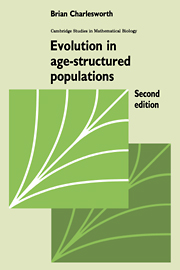Book contents
- Frontmatter
- Contents
- Preface
- Preface to the second edition
- 1 Models of age-structured populations
- 2 The genetics of populations without selection
- 3 Selection: construction of a model and the properties of equilibrium populations
- 4 Selection: dynamic aspects
- 5 The evolution of life-histories
- Appendix 1 Generating functions and their properties
- Appendix 2 Asymptotic values of ρpi and 2ρi
- References
- Author index
- Subject index
4 - Selection: dynamic aspects
Published online by Cambridge University Press: 18 December 2009
- Frontmatter
- Contents
- Preface
- Preface to the second edition
- 1 Models of age-structured populations
- 2 The genetics of populations without selection
- 3 Selection: construction of a model and the properties of equilibrium populations
- 4 Selection: dynamic aspects
- 5 The evolution of life-histories
- Appendix 1 Generating functions and their properties
- Appendix 2 Asymptotic values of ρpi and 2ρi
- References
- Author index
- Subject index
Summary
Introduction
This chapter is concerned primarily with the analysis of the process of gene frequency change under selection in age-structured populations, in particular with the question: to what extent can this process be understood in terms of fixed parameters which characterise individual genotypes, analogous to the fitnesses of genotypes in discrete-generation models? The first investigation of the problem of the dynamics of selection in the context of age-structured populations was that of Norton (1928). (According to Haldane (1927a), Norton started work on the problem as early as 1910 and had established his results by 1922.) He studied the case of a single diallelic locus with time-independent and density-independent demographic parameters for each genotype, with no sex-differences, using the continuous-time equivalents of equations (3.14). He showed that the long-term results of selection (whether one of a pair of alleles is fixed or a polymorphism is maintained) are completely predicted by the relationships between the intrinsic rates of increase of the three genotypes, in the same way that the outcome of selection can be predicted from the genotypic fitnesses in the discrete-generation case. Haldane (1927a) established some approximate results for the rates of spread of rare dominant and recessive genes in slowly growing populations, and concluded that selection proceeded in much the same way as in the discrete-generation case. Both Haldane and Norton based their work on equations which explicitly incorporated the characteristics of age-structured populations, in contrast to the approach of Fisher (1930, 1941) who used differential equations to describe gene frequency change with continuous-time models but did not derive these from more basic equations.
- Type
- Chapter
- Information
- Evolution in Age-Structured Populations , pp. 136 - 188Publisher: Cambridge University PressPrint publication year: 1994



